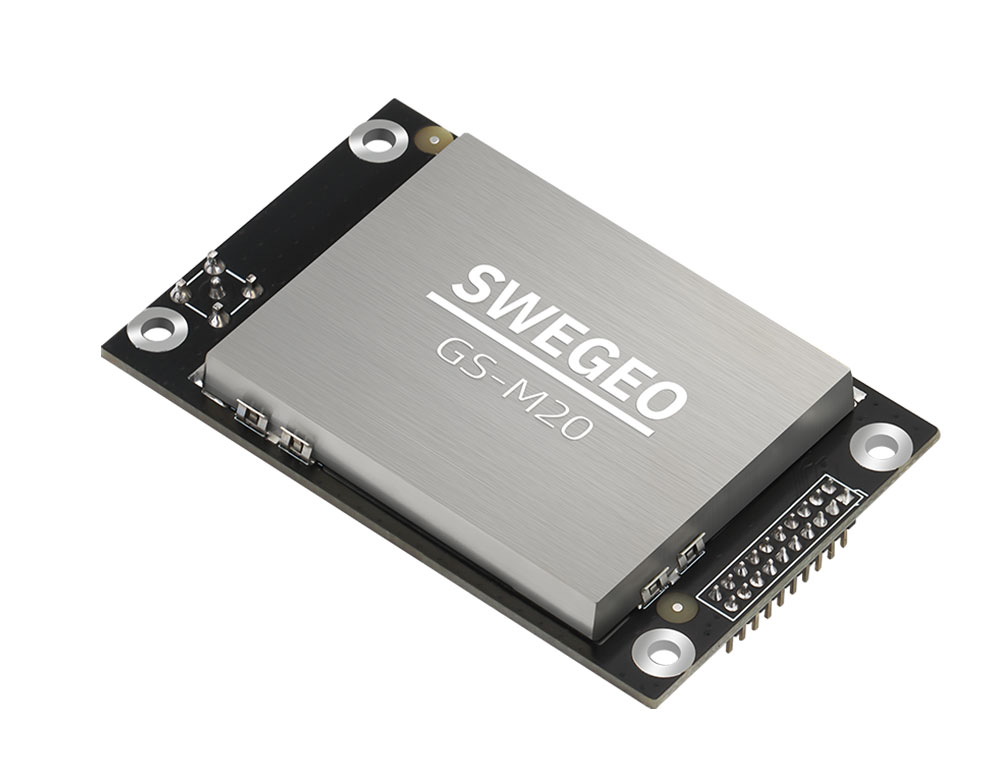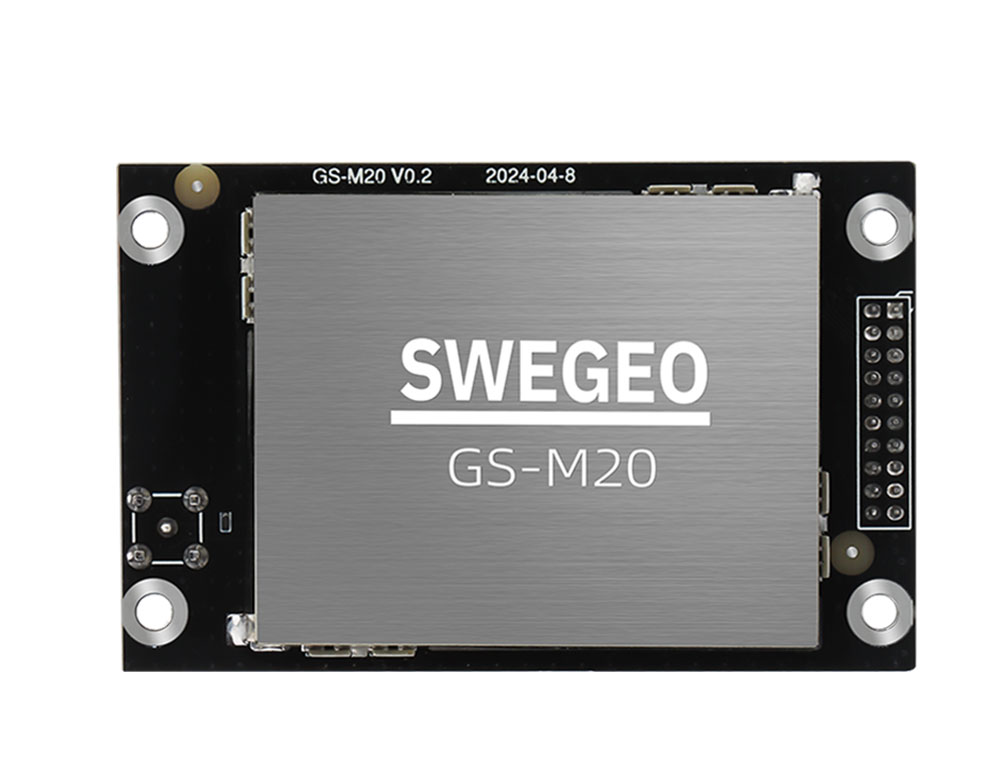

Swegeo GS-M20
Single Antenna GNSS Receiver Board
Key Feature
The SweGeo GS-M20 board offers seamless, real-time, and high-precision positioning even in challenging and signal-disrupted environments. With its integrated design, superior performance, low power consumption, and compact form factor, the GS-M20 stands out as an ideal solution for various applications including autonomous driving, advanced driver assistance systems, lane-level navigation, drones, intelligent robots, precision agriculture, surveying, and mapping. This module ensures exceptional performance and reliability, making it a perfect fit for your projects that demand high accuracy and integration.
Based on Alice, the 22 nm process GNSS SoC
The GS-M20 board is powered by the Alice GNSS System-on-Chip, which is manufactured using an advanced 22 nm process technology. This enables high performance with lower power consumption and a compact design, ensuring efficient and reliable operation.
Full-constellation and full-frequency (1507 channels)
The board supports all major global navigation satellite systems (GNSS), including GPS, GLONASS, Galileo, and BeiDou, across all available frequency bands. With 1507 channels, it provides comprehensive coverage and enhanced accuracy in positioning.
L-Band and CLAS supported
The GS-M20 supports L-Band signals and the Centimeter Level Augmentation Service (CLAS), which are crucial for high-precision positioning applications. This makes it suitable for industries that require precise location data, such as autonomous driving and precision agriculture.
NRTK/PPP/PPP-RTK supported
The board is compatible with Network Real-Time Kinematic (NRTK), Precise Point Positioning (PPP), and PPP-Real-Time Kinematic (PPP-RTK) technologies. These advanced positioning techniques improve accuracy and reliability, even in challenging environments.
Anti-jamming and anti-spoofing
The GS-M20 features robust anti-jamming and anti-spoofing capabilities, ensuring the integrity and reliability of the positioning data. This is especially important in environments with potential signal interference or malicious attacks.
Various interfaces
The board offers multiple interfaces for easy integration with different systems and devices. This flexibility allows it to be used in a wide range of applications, from autonomous vehicles to drones and intelligent robotics.
utonomous Driving & ADAS Platforms:
The GS-M20 is a high-precision module suited for the needs of autonomous vehicle developers and advanced driver-assistance systems. Car OEMs and researchers integrate this board into their guidance systems to achieve lane-level navigation accuracy. For example, in an autonomous test vehicle, the GS-M20 provides real-time positioning that allows the car to stay centered in its lane and precisely approach waypoints. Its resilience in multipath and urban environments (courtesy of full dual-frequency tracking and strong anti-spoofing) makes it dependable for city driving. The support for augmentation services like PPP-RTK and Japan’s CLAS means it can be used globally, from highway driving to pilot projects of self-driving taxis, maintaining accuracy even without a dense RTK network.
Precision Farming & Machinery Automation:
The GS-M20 serves well in precision ag equipment that demands reliable positioning under open sky as well as near tree lines or hills. Manufacturers of smart tractors and crop-sprayers use this board to enable autonomous operation—guiding machinery along predefined paths with high repeatability. Even in large fields where internet connectivity is limited, the GS-M20 can leverage its PPP mode to get corrections via L-Band satellite, ensuring that tractors maintain accuracy for seeding and fertilization. Its low power usage also appeals to battery-operated farm sensors or yield monitors that need to log position data throughout the day without taxing the vehicle’s power supply.
Aerial Mapping & Survey Drones:
Survey-grade drone systems incorporate the GS-M20 for its combination of precision and compact design. A fixed-wing mapping drone, for instance, equipped with this board can fly long corridors or large areas, and the on-board GNSS will deliver consistent 3D coordinates for each image captured. The 22nm Alice SoC inside contributes to low power consumption, extending the drone’s flight time. Importantly, the board’s ability to handle NRTK and even stand-alone PPP means that whether the drone team has access to an RTK network or not, they can still achieve high accuracy (either real-time or through post-processing the logged data). This flexibility is great for surveyors who might work in diverse regions and conditions.
| Feature | Specification | Feature | Specification |
|---|---|---|---|
| Signal Support |
L-Band (3 channels, 1525~1559 MHz) BDS-2: B1I, B2I, B3I BDS-3: B1I, B1C, B2a, B2b (PPP), B3I GPS: L1 C/A, L1C, L2, L5 GLONASS: G1, G2 Galileo: E1, E5a, E5b, E6 QZSS: L1 C/A, L1C, L2, L5, L6 NavIC (IRNSS): L5 SBAS: L1 C/A |
Channels | 1507 Channels |
| Horizontal Positioning Accuracy |
Single Point: 1.5 m (RMS) RTK: 1 cm + 1 ppm (RMS) |
Vertical Positioning Accuracy |
Single Point: 2.5 m (RMS) RTK: 1.5 cm + 1 ppm (RMS) |
| Data Update Rate |
GNSS Observation: 10 Hz GNSS Position Results: 10 Hz |
RTK Performance |
RTK Initialization: ≤5 s RTK Solution Delay: ≤50 ms Re-acquisition Time: ≤1 s |
| Time to First Fix |
Cold Start: ≤30 s Hot Start: ≤5 s |
Timing Accuracy | 20 ns (RMS) |
| Velocity Accuracy | 0.03 m/s (RMS) | Anti-jamming |
Categories: Single-frequency, Multitone, Sweeping, Pulse, Narrowband Interference-Signal Ratio: 65 dBc |
| Dimensions | 71.1 × 45.7 × 1.62 mm | Weight | 644 g |
| Input Voltage | 3.3 V DC | Connectors |
RS232 × 2 USB × 1 Bluetooth (Long Range SPP) |
| Operating Temperature | -40°C ~ +85°C | Storage Temperature | -40°C ~ +105°C |
| Humidity | 95% Non-condensing | Vibration / Shock | JESD22-B103 / JESD22-B110 |


Swegeo GS-M20
Dual Antenna GNSS/INS Receiver Board
Key Feature
The Swegeo GD21D-INS board is designed to deliver high-precision navigation capabilities in a compact form factor. It features advanced anti-jamming technology with 65 dBc narrowband suppression and high-performance RTK for reliable positioning. The board offers a deeply-coupled combined navigation solution to address challenges such as satellite signal interference and multipath effects. It provides continuous, real-time, and accurate position and attitude information, making it ideal for applications including automated driving, drones, precision agriculture, surveying, and mapping.
OVERVIEW
Multi-Constellation GNSS Support
Provides reliable and robust signal reception from GPS, GLONASS, Galileo, and
BeiDou systems, ensuring comprehensive coverage and improved accuracy.
Dual Antenna Configuration
Enhances positioning accuracy and performance, particularly in challenging
environments, by using two antennas to better mitigate signal obstructions and
multipath effects.
USE CASES
utonomous Driving & ADAS Platforms:
The GS-M20 is a high-precision module suited for the needs of autonomous vehicle developers and advanced driver-assistance systems. Car OEMs and researchers integrate this board into their guidance systems to achieve lane-level navigation accuracy. For example, in an autonomous test vehicle, the GS-M20 provides real-time positioning that allows the car to stay centered in its lane and precisely approach waypoints. Its resilience in multipath and urban environments (courtesy of full dual-frequency tracking and strong anti-spoofing) makes it dependable for city driving. The support for augmentation services like PPP-RTK and Japan’s CLAS means it can be used globally, from highway driving to pilot projects of self-driving taxis, maintaining accuracy even without a dense RTK network.
Precision Farming & Machinery Automation:
The GS-M20 serves well in precision ag equipment that demands reliable positioning under open sky as well as near tree lines or hills. Manufacturers of smart tractors and crop-sprayers use this board to enable autonomous operation—guiding machinery along predefined paths with high repeatability. Even in large fields where internet connectivity is limited, the GS-M20 can leverage its PPP mode to get corrections via L-Band satellite, ensuring that tractors maintain accuracy for seeding and fertilization. Its low power usage also appeals to battery-operated farm sensors or yield monitors that need to log position data throughout the day without taxing the vehicle’s power supply.
Aerial Mapping & Survey Drones:
Survey-grade drone systems incorporate the GS-M20 for its combination of precision and compact design. A fixed-wing mapping drone, for instance, equipped with this board can fly long corridors or large areas, and the on-board GNSS will deliver consistent 3D coordinates for each image captured. The 22nm Alice SoC inside contributes to low power consumption, extending the drone’s flight time. Importantly, the board’s ability to handle NRTK and even stand-alone PPP means that whether the drone team has access to an RTK network or not, they can still achieve high accuracy (either real-time or through post-processing the logged data). This flexibility is great for surveyors who might work in diverse regions and conditions.
APPLICATIONS


TECHNICAL SPECIFICATIONS
| Feature | Specification | Feature | Specification |
|---|---|---|---|
| Signal Support |
L-Band (3 channels, 1525~1559 MHz) BDS-2: B1I, B2I, B3I BDS-3: B1I, B1C, B2a, B2b (PPP), B3I GPS: L1 C/A, L1C, L2, L5 GLONASS: G1, G2 Galileo: E1, E5a, E5b, E6 QZSS: L1 C/A, L1C, L2, L5, L6 NavIC (IRNSS): L5 SBAS: L1 C/A |
Channels | 1507 Channels |
| Horizontal Positioning Accuracy |
Single Point: 1.5 m (RMS) RTK: 1 cm + 1 ppm (RMS) |
Vertical Positioning Accuracy |
Single Point: 2.5 m (RMS) RTK: 1.5 cm + 1 ppm (RMS) |
| Data Update Rate |
GNSS Observation: 10 Hz GNSS Position Results: 10 Hz |
RTK Performance |
RTK Initialization: ≤5 s RTK Solution Delay: ≤50 ms Re-acquisition Time: ≤1 s |
| Time to First Fix |
Cold Start: ≤30 s Hot Start: ≤5 s |
Timing Accuracy | 20 ns (RMS) |
| Velocity Accuracy | 0.03 m/s (RMS) | Anti-jamming |
Categories: Single-frequency, Multitone, Sweeping, Pulse, Narrowband Interference-Signal Ratio: 65 dBc |
| Dimensions | 71.1 × 45.7 × 1.62 mm | Weight | 644 g |
| Input Voltage | 3.3 V DC | Connectors |
RS232 × 2 USB × 1 Bluetooth (Long Range SPP) |
| Operating Temperature | -40°C ~ +85°C | Storage Temperature | -40°C ~ +105°C |
| Humidity | 95% Non-condensing | Vibration / Shock | JESD22-B103 / JESD22-B110 |


